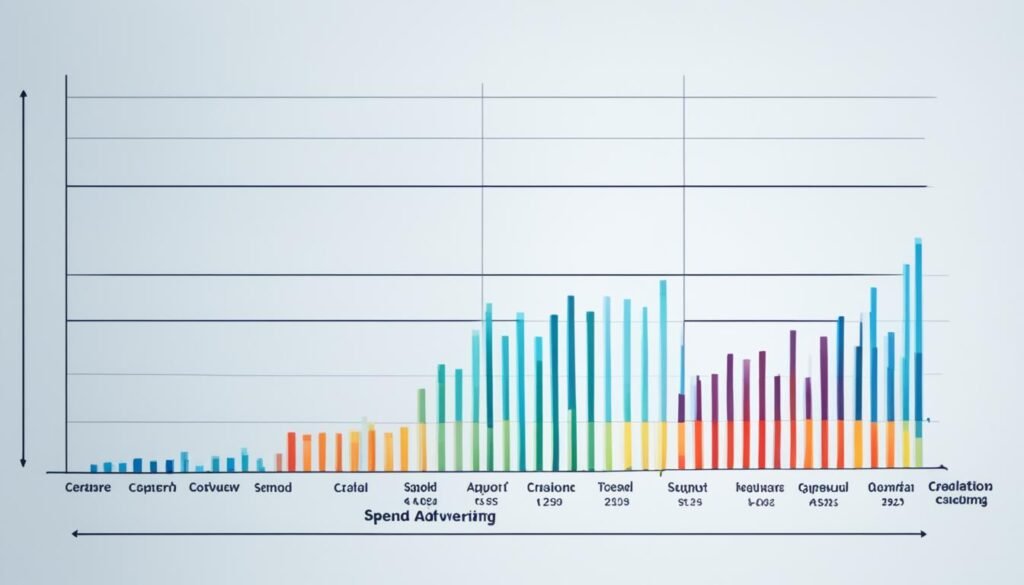Advertising has a powerful influence on consumer behavior by shaping their perceptions, attitudes, and purchasing decisions. It is a strategic communication tool that aims to persuade consumers to buy products or services, using various techniques and tactics to capture their attention and evoke desired actions.
Advertisements often emphasize products or services as status symbols, appealing to consumers’ desire for social recognition and validation. By showcasing aspirational lifestyles and success stories, advertising creates a sense of aspiration and fosters the belief that acquiring certain products or services will elevate one’s social standing.
Additionally, advertising plays on consumers’ fears and insecurities. It identifies and exploits pain points, highlighting the problems consumers face and positioning the advertised solution as the ultimate remedy. Whether it’s a skincare product promising flawless skin or a weight loss program guaranteeing a slim figure, advertising taps into consumers’ vulnerability and offers a solution.
Furthermore, the influence of advertising on consumer behavior begins at an early age. Children and adolescents are highly susceptible to advertising messages and can be influenced by the marketed products or services. As they grow older, these early impressions can shape their preferences and purchasing habits well into adulthood.
It is crucial for consumers to be aware of the influence of advertising on their behavior. By understanding the persuasive techniques used in advertisements, consumers can make more informed choices and consider the factors beyond the marketing hype. This awareness allows individuals to critically evaluate the messages conveyed by advertisements and make decisions that align with their true needs and values.
Key Takeaways: Advertising Influence Consumer Behavior
- Advertising has a significant impact on consumer behavior, shaping their perceptions, attitudes, and purchasing decisions.
- Advertisements often emphasize products or services as status symbols and play on consumers’ fears and insecurities.
- The influence of advertising starts at an early age, shaping preferences and habits that can persist into adulthood.
- Awareness of advertising techniques empowers consumers to make more informed choices and align their decisions with their true needs and values.
The Influence of Marketing and Advertising on Consumer Health
Marketing and advertising play a crucial role in shaping consumer health decisions. Advertisers employ persuasive techniques to position products and services as solutions to health issues, capitalizing on consumers’ desire for convenient remedies. However, it is important for consumers to be aware of the risks associated with fraudulent health products and the prevalence of health fraud scams.
“The power of marketing and advertising in influencing consumer health decisions cannot be underestimated. Advertisements often create a sense of urgency and exploit consumers’ fears and desires for a quick fix. Consumers need to be empowered to make informed decisions about their health and not fall victim to misleading claims and deceptive practices.” – Dr. Emily Roberts, Consumer Health Expert
While marketing and advertising campaigns promote various health-related products and services, it is essential for consumers to critically evaluate the information presented. The influence of advertising on consumer health extends beyond the physical products itself. It also encompasses lifestyle choices, dietary preferences, and brand loyalty. Advertisers strategically create associations between their products and health benefits, appealing to consumers’ emotions and aspirations.
However, it is crucial for consumers to approach health-related advertising with caution. False and misleading claims can misguide consumers into purchasing ineffective or potentially harmful products. Awareness of red flags, such as exaggerated claims, miracle cures, and concealed ingredients, can help consumers make informed choices and protect their well-being.
Consumers should consider seeking trustworthy sources of information, such as healthcare professionals, scientific studies, and regulatory bodies, to validate health-related claims promoted through marketing and advertising. In an era of abundant information, it is essential to prioritize evidence-based decision-making rather than succumbing to persuasive messaging alone.
The Risks of Health Fraud Scams
Health fraud scams continue to pose a significant threat to consumers’ well-being. These scams often involve deceptive advertising practices, promising quick and effortless solutions to health problems. Fraudulent products may claim to cure serious diseases or offer weight loss results without any scientific evidence or regulatory approval.
Consumers should be vigilant and watch out for the following signs of health fraud scams:
- Too good to be true claims: Be cautious of products or services that promise extraordinary results with no effort or have exaggerated claims without any scientific evidence.
- Unproven ingredients or methods: Research the ingredients and methods used in health products to ensure they have undergone rigorous testing and are supported by reputable studies.
- Pressure tactics: Scammers often use high-pressure sales tactics or limited-time offers to create a sense of urgency and persuade consumers to make impulsive decisions.
- Misleading testimonials and endorsements: Be skeptical of testimonials and endorsements that seem unrealistic or come from unidentified or biased individuals.
- No money-back guarantees: Legitimate companies often provide money-back guarantees if their products fail to deliver the promised results. Scammers, on the other hand, may avoid such guarantees.
To protect consumer health, regulatory agencies and law enforcement bodies actively work to identify and shut down health fraud scams. Additionally, consumers can report suspected scams to organizations like the Federal Trade Commission (FTC) and the Food and Drug Administration (FDA) to help prevent others from falling victim to deceptive marketing and advertising practices.
By staying informed, critically evaluating health claims, and reporting suspicious activities, consumers can safeguard their health and make informed decisions when it comes to health-related products and services.
How to Address Issues with Consumer Products or Services

When consumers encounter problems with purchased items or services, it is important to follow specific steps to address the issue. By taking prompt action, consumers can resolve their concerns and ensure their rights are protected. Here are the essential steps to address any issues with consumer products or services:
1. Gather Supporting Documents
Before reaching out to the seller, gather all relevant documents related to your purchase. This includes receipts, order confirmations, warranties, and any correspondence with the seller. Having these documents ready will help you clearly communicate your concern when addressing the issue.
2. Contact the Seller Directly
Start by contacting the seller or service provider directly to explain the problem you are experiencing. Be polite but firm in your communication, clearly stating your expectations for resolution. Provide all necessary details, such as order numbers, product specifications, or service agreements, to help expedite the process. Keep a record of all communication for future reference.
3. Seek Assistance from Consumer Protection Offices
If you are unable to resolve the issue directly with the seller, consider reaching out to consumer protection offices. These organizations specialize in addressing consumer complaints and can offer guidance and mediation services. They can also provide information on consumer rights and legal recourse if required.
4. Contact the Better Business Bureau
The Better Business Bureau (BBB) is a renowned resource for consumer advocacy and dispute resolution. They provide a platform for consumers to submit complaints and facilitate communication between consumers and businesses. Submitting a complaint to the BBB can prompt the seller to take action and address your concerns promptly.
5. Seek Legal Help
If all other avenues fail to provide a satisfactory resolution, it may be necessary to seek legal assistance. Consult with a consumer protection attorney who specializes in consumer rights and product/service disputes. They can provide guidance on legal options, negotiate on your behalf, or represent you in court if necessary.
Remember, it is crucial to act promptly when encountering issues with consumer products or services. By following these steps and seeking the appropriate assistance, you can protect your rights as a consumer and work towards a fair resolution of your concern.
| Steps to Address Issues with Consumer Products or Services | |
|---|---|
| 1 | Gather Supporting Documents |
| 2 | Contact the Seller Directly |
| 3 | Seek Assistance from Consumer Protection Offices |
| 4 | Contact the Better Business Bureau |
| 5 | Seek Legal Help |
The Psychological Impact of Advertising on Consumer Happiness

Advertising messages have a profound influence on consumer happiness, as they often promote the idea that material possessions are essential for achieving happiness. Advertisements create a desire for products and services, leading to a phenomenon known as retail therapy, where individuals seek happiness through impulsive buying behavior.
However, research indicates that happiness is not solely determined by material wealth. While advertising can momentarily evoke feelings of joy and excitement, it does not guarantee long-term satisfaction or fulfillment. True happiness is a complex construct influenced by various factors such as personal relationships, self-fulfillment, and a sense of purpose.
It is crucial for consumers to recognize that their well-being cannot be solely reliant on material possessions. By understanding the psychological impact of advertising, individuals can make more informed decisions and prioritize those aspects of life that truly contribute to their long-term happiness.
“The greatest happiness you can have is knowing that you do not necessarily require happiness.”
– William Saroyan
The Pursuit of Happiness Beyond Material Possessions
Advertising often portrays happiness as something that can be acquired through external means, such as owning a particular product or achieving a certain lifestyle. However, true happiness extends beyond material possessions and encompasses intangible aspects that bring a sense of fulfillment.
Developing meaningful relationships, pursuing personal growth, engaging in community involvement, and prioritizing mental and physical well-being are essential elements in the pursuit of long-lasting happiness. These factors contribute to a sense of purpose and contentment that cannot be bought through commercial means.
Guarding Against Manipulative Advertising Tactics
Advertising can sometimes manipulate emotions and create a false sense of happiness. Advertisers leverage human desires, fears, and insecurities to promote their products and services. Recognizing these manipulative tactics can help consumers make informed decisions and resist impulsive purchases driven solely by the allure of momentary happiness.
Consumers can adopt critical thinking skills, question the intentions behind advertisements, and seek out truthful information about a product or service before making a purchasing decision. By understanding their own values and priorities in life, individuals can guard against falling prey to deceptive marketing tactics.
Investing in Experiences and Well-Being
Instead of seeking happiness through material possessions, consumers can focus their resources on experiences that bring genuine fulfillment. Studies have shown that investing in experiences, such as travel, hobbies, and quality time with loved ones, can contribute significantly to long-term happiness.
Additionally, prioritizing well-being through activities like practicing gratitude, mindfulness, and self-care can enhance overall happiness and contentment. By valuing experiences and well-being over material possessions, consumers can cultivate a more sustainable and meaningful source of happiness in their lives.
| Advertising Messages | Consumer Happiness |
|---|---|
| Promote material possessions as the primary source of happiness | May create temporary feelings of joy, but does not guarantee long-term satisfaction or fulfillment |
| Evoke desires for products and services through persuasive techniques | Consumers may engage in retail therapy and impulsive buying behavior |
| Manipulate emotions and create a false sense of happiness | Consumers can guard against manipulative tactics by developing critical thinking skills |
| Shift focus to experiences and well-being | Investing in experiences and prioritizing well-being contributes to long-term happiness |
Understanding the psychological impact of advertising on consumer happiness empowers individuals to make conscious choices that align with their values and well-being. By recognizing the limitations of material possessions in providing lasting happiness, consumers can cultivate a more fulfilling and contented life.
The Impact of Advertising on Brand Awareness and Brand Loyalty

Advertising plays a crucial role in creating brand awareness and building brand loyalty among consumers. By strategically designing and implementing effective advertising campaigns, brands can establish their identity and reputation, making consumers more likely to choose their products or services over competitors.
When consumers are exposed to consistent and impactful advertising messages, it increases their brand recognition. This means that they become familiar with the brand’s name, logo, and overall image, allowing them to easily identify and remember the brand when making purchasing decisions.
Furthermore, advertising helps create a sense of familiarity and trust with the target audience. When consumers see a brand’s advertisements repeatedly, it builds a level of familiarity, which in turn, enhances their trust in the brand. This familiarity and trust are essential in establishing a positive brand-consumer relationship, leading to a higher likelihood of brand loyalty.
“The more consumers are exposed to a brand’s advertising, the more likely they are to develop a positive perception of the brand, strengthening their loyalty.”
Brand loyalty is crucial for businesses as it not only drives repeat purchases but also generates positive word-of-mouth advertising. When consumers have a strong affinity toward a brand, they are more likely to recommend it to others, further enhancing brand awareness.
Ultimately, the impact of advertising on brand awareness and brand loyalty is instrumental in distinguishing a brand from its competitors and creating a lasting impression in the minds of consumers.
| Benefits of Advertising on Brand Awareness and Brand Loyalty | Examples |
|---|---|
| Increased consumer recognition and recall | The McDonald’s golden arches instantly recognizable by consumers worldwide. |
| Established brand identity and reputation | The Nike swoosh symbolizes performance, athleticism, and innovation. |
| Enhanced consumer trust and familiarity | Coca-Cola’s consistent holiday commercials create a sense of nostalgia among consumers. |
| Higher likelihood of repeat purchases | Apple users are often loyal to the brand, consistently purchasing new iPhones, MacBooks, and other Apple products. |
| Positive word-of-mouth advertising | Many coffee lovers rave about Starbucks and recommend it to friends and family. |
The Role of Advertising in Influencing Consumer Purchase Decisions

When it comes to consumer purchase decisions, advertising plays a crucial role. It has the power to shape consumer attitudes, create a sense of urgency, and provide valuable information about the benefits and features of a product or service. By employing effective advertising techniques, marketers can sway consumer preferences and increase the likelihood of making a purchase.
One of the key ways in which advertising influences consumer purchase decisions is through the use of celebrity endorsements. When a well-known celebrity endorses a product or service, consumers often associate the brand with the celebrity’s positive qualities and trust their judgment. This can lead to an increased desire to own the endorsed product and ultimately drive purchase decisions.
Another technique that advertisers employ to influence consumer purchase decisions is social proof. When consumers see others endorsing or using a particular product, it creates a sense of trust and reliability. Testimonials, reviews, and ratings are powerful forms of social proof that can sway consumer preferences and increase the likelihood of making a purchase.
Furthermore, advertising provides consumers with important information about the benefits and features of a product or service. By highlighting what sets their offering apart, advertisers can influence consumer perceptions and increase the perceived value of the product. This can lead to a higher willingness to pay and ultimately drive purchase decisions.
Advertising has a direct influence on consumer purchase decisions. It can create a sense of urgency, influence consumer attitudes, and provide information about the benefits and features of a product or service.
The Influence of Advertising Channels on Purchase Decisions
There are various advertising channels that can influence consumer purchase decisions. Traditional channels such as television, radio, and print media still play a significant role in reaching a wide audience. However, with the rise of digital marketing, online advertising has become increasingly important.
Online advertising allows marketers to target specific demographics and personalize their messages. Social media platforms like Facebook, Instagram, and Twitter provide opportunities for highly targeted advertising, making it easier to reach consumers who are likely to be interested in a particular product or service. Additionally, search engine advertising allows marketers to display ads to users actively searching for relevant information, increasing the likelihood of a purchase.
Mobile advertising is another channel that has gained prominence in recent years. With the widespread use of smartphones, marketers can reach consumers on-the-go and influence their purchase decisions in real-time. By leveraging location-based targeting and personalized messaging, mobile advertising can create a sense of urgency and prompt consumers to make immediate purchase decisions.
The Mobile Advertising Impact on Consumer Purchase Decisions
Smartphones have become an integral part of consumers’ lives, and mobile advertising has a significant impact on their purchase decisions. With the increasing reliance on mobile devices for information and entertainment, consumers are exposed to a constant stream of mobile advertisements throughout the day.
Mobile advertising not only provides consumers with information about products and services but also offers convenience and instant access to purchase options. For example, mobile ads often include clickable links that direct users to product pages or online stores, making it easy for consumers to make a purchase immediately.
In addition, mobile advertising can leverage location data to deliver targeted messages based on a user’s physical location. This allows advertisers to create personalized experiences and offers that are highly relevant to the consumer’s current situation. For instance, a mobile user may receive a notification about a nearby sale or a limited-time offer that encourages them to visit a store and make a purchase.
Overall, the role of advertising in influencing consumer purchase decisions cannot be underestimated. It has the power to shape consumer attitudes, create a sense of urgency, and provide valuable information. By understanding the impact of advertising and utilizing effective advertising techniques, marketers can influence consumer behavior and drive purchase decisions.
| Advertising Techniques | Influence on Consumer Purchase Decisions |
|---|---|
| Celebrity Endorsements | Associations with positive qualities and trust |
| Social Proof | Trust and reliability through endorsements and testimonials |
| Information Provision | Highlighting benefits and features to increase perceived value |
The Influence of Advertising on Consumer Behavior in the Digital Age

As we continue to embrace the digital age, advertising techniques have adapted to target consumers online, making a profound impact on consumer behavior. Platforms like Facebook and Twitter have become influential players in shaping consumer choices through the use of targeted ads and personalized messaging.
With the advancement of data analytics and online tracking, advertisers can now reach specific target audiences more effectively than ever before. This ability to tailor advertisements based on user preferences and behaviors has significantly enhanced the power of advertising to influence consumer decision-making.
The Impact of Targeted Advertising
Targeted advertising, made possible by the digital landscape, enables marketers to deliver relevant messages to consumers who have already shown interest in their products or services. By leveraging user data, such as browsing history, demographics, and interests, advertisers can create highly tailored campaigns that resonate with the target audience.
“Through targeted advertising, brands can build a more personal and intimate connection with consumers, fostering a sense of trust and familiarity.”
This personalized approach allows advertisers to address specific consumer needs, pain points, and desires, making their messages more compelling and impactful. The result is a higher likelihood of consumer engagement and conversion, ultimately influencing consumer behavior in favor of the advertised products or services.
The Power of Social Media Advertising
Social media platforms have revolutionized the advertising landscape, offering unparalleled opportunities to engage with consumers in real-time. The ability to target specific demographics, interests, and behaviors has made social media advertising a formidable force in influencing consumer behavior.
“Social media advertising provides a platform for brands to establish a direct and interactive connection with their target audience, fostering brand loyalty and driving consumer decisions.”
Through interactive ads, influencer collaborations, and user-generated content campaigns, brands can create a sense of community and belonging, encouraging consumers to engage with the brand and make purchasing decisions.
The Rise of Influencer Marketing
An emerging trend in the digital age is the rise of influencer marketing. Influencers, who have established a significant following and strong online presence, can greatly influence the purchasing decisions of their followers through sponsored content and endorsements.
By partnering with influencers who align with their target audience, brands can leverage the influence and trust that these individuals have built, amplifying their reach and persuasiveness. This form of advertising taps into consumers’ aspirations and desires, making it a powerful tool in shaping consumer behavior.
Data Analytics and Consumer Insights
The digital age has brought about a wealth of consumer data that marketers can analyze to gain valuable insights into consumer behavior and preferences. By harnessing the power of data analytics, advertisers can better understand their target audience, refine their messaging, and improve the effectiveness of their campaigns.
Data-driven insights allow brands to optimize their advertising strategies, ensuring that they reach the right consumers, at the right time, with the right message. This level of precision targeting drives consumer behavior by delivering messages that resonate with individual needs and desires.
| Benefits of Advertising in the Digital Age | Challenges of Advertising in the Digital Age |
|---|---|
|
|
The Impact of Advertising on Consumer Attitudes and Perceptions

Advertising has a profound effect on consumer attitudes and perceptions, influencing how individuals perceive products or brands. Through strategic messaging and creative campaigns, advertising has the power to shape consumer sentiments and attitudes towards a particular product or brand.
One way that advertising influences consumer attitudes is by creating positive associations. Advertisements often evoke emotions and portray desirable experiences or outcomes associated with a product or brand. By highlighting the benefits and positive attributes of a product, advertising can create a sense of positivity and desirability in the minds of consumers.
Furthermore, effective advertising can also establish emotional connections with consumers. Brands that successfully tap into consumers’ emotions can create a sense of familiarity, trust, and loyalty. By leveraging emotional appeals, advertising can shape consumers’ perception of a particular brand, fostering positive attitudes and a deeper connection.
“Advertising has the power to shape consumer attitudes and perceptions, creating positive associations and emotional connections.”
Advertisements that align with consumer values are particularly effective in shaping attitudes and perceptions. Today’s consumers are increasingly conscious of social issues, sustainability, and ethical practices. Brands that reflect these values in their advertising campaigns can strike a chord with consumers, leading to favorable attitudes and perceptions.
Additionally, advertising that resonates with consumers’ emotions can have a significant impact on attitudes and perceptions. Emotional appeals, such as storytelling or relatable scenarios, make advertisements more memorable and relatable. This emotional connection can influence how consumers perceive and engage with a brand, ultimately driving their purchasing decisions.
In summary, advertising plays a crucial role in shaping consumer attitudes and perceptions. By creating positive associations, establishing emotional connections, and aligning with consumer values, advertising can significantly influence how consumers perceive products or brands. Understanding the impact of advertising on consumer attitudes and perceptions is essential for marketers seeking to build successful and effective advertising campaigns.
The Effectiveness of Different Advertising Techniques and Strategies

Different advertising techniques and strategies play a crucial role in influencing consumer behavior. Marketers utilize various approaches to enhance the effectiveness of their advertisements and persuade consumers to take action. Let’s explore some commonly used advertising techniques and strategies that contribute to the success of marketing campaigns.
Informative Advertising
Informative advertising aims to educate consumers about a product or service’s features, benefits, and value proposition. By providing relevant and accurate information, this approach helps consumers make informed purchasing decisions. Informative advertising can be particularly effective when introducing a new product or highlighting unique aspects that differentiate it from competitors.
Persuasive Appeals
Persuasive appeals in advertising involve appealing to consumers’ emotions, desires, and aspirations. Advertisements often evoke emotions such as happiness, nostalgia, or fear to create a connection with the target audience. By leveraging emotional appeal, advertisers can elicit a desired response and influence consumer behavior. For example, an advertisement for a luxury watch may use imagery and storytelling to evoke a feeling of prestige and exclusivity.
Emotional Advertising
Emotional advertising focuses on creating a strong emotional connection between the brand and the consumer. By tapping into feelings of joy, love, or compassion, advertisers aim to elicit a positive emotional response that strengthens brand loyalty and drives consumer engagement. Emotional advertising can be particularly effective in branding campaigns, as it helps consumers form a deep bond with the brand that goes beyond product features or benefits.
Comparative Advertising
Comparative advertising involves directly comparing a brand or product to its competitors. This technique aims to highlight the superiority or unique selling points of a particular brand, influencing consumers to choose it over others. Comparative advertising can be effective when used strategically and ethically, providing consumers with transparent and accurate information to aid their decision-making process.
The success of advertising techniques and strategies depends on several factors, including the target audience, industry, and campaign objectives. It is essential for marketers to understand their audience and tailor their advertising approaches accordingly to maximize their effectiveness.
Enhancing Advertisements
When utilizing different advertising techniques and strategies, it is crucial to employ additional elements that enhance the persuasive impact of advertisements. Elements such as persuasive language, visual cues, and endorsements can strengthen the effectiveness of advertising campaigns.
| Technique/Strategy | Example | Effectiveness |
|---|---|---|
| Informative Advertising | An advertisement providing detailed information about the features and benefits of a new smartphone. | High |
| Persuasive Appeals | An advertisement evoking a sense of urgency by offering a limited-time discount. | Moderate |
| Emotional Advertising | An advertisement using heartwarming storytelling to build an emotional connection with the audience. | High |
| Comparative Advertising | An advertisement showcasing the superior performance of a laundry detergent compared to competing brands. | Varies (Dependent on campaign execution) |
By employing effective advertising techniques and strategies, marketers can capture consumers’ attention, influence their perceptions, and motivate them to take action. Understanding the diverse range of advertising approaches available and utilizing them strategically can enhance the effectiveness of marketing campaigns and drive desired consumer behavior.
The Long-Term Impact of Advertising on Consumer Behavior

While most studies focus on the short-term effects of advertising, it is crucial to consider the long-term impact it has on consumer behavior. Advertising has the power to shape consumer preferences, brand loyalty, and purchasing habits over an extended period.
The repeated exposure to advertisements and consistent messaging can create lasting effects on consumer behavior. When consumers consistently encounter advertising that promotes specific products or brands, it influences their perceptions and attitudes, ultimately affecting their buying decisions. Advertisements play a significant role in establishing brand recognition and familiarity, contributing to increased trust and preference among consumers.
Furthermore, advertising contributes to the formation of consumer habits and routines. Through consistent exposure, consumers become accustomed to certain brands or products, making them more likely to choose them repeatedly. As a result, advertising can shape consumer behavior by encouraging repeat purchases and fostering brand loyalty in the long run.
Consumer behavior is not solely influenced by immediate needs and desires but is also shaped by long-term exposure to persuasive advertising messages. Advertisers understand the potential impact they can have on consumer behavior and strategically develop campaigns that aim to create positive and lasting associations between their brands and consumers.
One example of the long-term impact of advertising on consumer behavior can be observed in the soft drink industry. Companies like Coca-Cola and Pepsi have invested heavily in advertising to establish their brands as popular choices. Through consistent messaging and creative campaigns that target various demographics, these brands have successfully cultivated a loyal consumer base that associates their respective products with enjoyment, refreshment, and social experiences.
The Role of Branding in Long-Term Advertising Impact
Branding plays a critical role in the long-term impact of advertising on consumer behavior. Building a strong, recognizable brand identity through advertising efforts ensures that consumers can easily associate products and services with specific companies.
Effective branding creates a sense of familiarity, trust, and loyalty among consumers, making them more likely to choose a particular brand over its competitors. Ongoing advertising campaigns that consistently communicate a brand’s values and unique selling points further reinforce this association and strengthen its impact on consumer behavior.
| Brand | Advertising Strategy | Long-Term Impact on Consumer Behavior |
|---|---|---|
| Coca-Cola | Global, emotionally-driven campaigns emphasizing happiness, unity, and sharing moments | Elevated brand recognition, strong preference, and repeated purchases |
| Apple | Sleek, minimalist advertising focusing on product features, design, and innovation | High brand loyalty, perception of quality and exclusivity, and continued customer advocacy |
| Nike | Athlete endorsements, inspiring storytelling, and empowering messaging | Association with athleticism, achievement, and motivation, leading to strong brand loyalty |
Table: Examples of Brands with Long-Term Advertising Impact on Consumer Behavior
The Influence of Emotional Appeals in Long-Term Advertising Impact
Emotional appeals in advertising have proven to be effective in leaving a long-lasting impact on consumer behavior. By evoking emotions such as happiness, nostalgia, or inspiration, advertisers can create a deep connection between their brand and consumers.
Emotional appeals in advertising have proven to be effective in leaving a long-lasting impact on consumer behavior.
For example, the iconic “Just Do It” campaign by Nike taps into consumers’ desire for personal achievement and motivation. Through powerful storytelling and athlete endorsements, Nike has successfully ingrained its brand identity in the minds of consumers, leading to long-term brand loyalty.
Emotional appeals create an emotional bond between the consumer and the brand, transcending the immediate need for a product or service. This connection can endure over time, influencing consumer behavior when making future purchasing decisions.
In conclusion, the long-term impact of advertising on consumer behavior is significant, shaping preferences, brand loyalty, and purchasing habits. Through repeated exposure to advertisements and consistent messaging, consumers develop associations with brands and establish behavioral patterns. Effective branding and emotional appeals further contribute to the long-term impact of advertising. Understanding these long-term effects helps marketers strategize their advertising campaigns and develop lasting relationships with their target audience.
Also Read : Master The Art Of Advertising Photography Today
Conclusion
Advertising has a significant influence on consumer behavior, shaping their perceptions, attitudes, and purchasing decisions. It plays a crucial role in creating brand awareness, building brand loyalty, and influencing consumer purchase decisions. By leveraging effective advertising techniques and strategies, marketers can effectively communicate the benefits and features of a product or service and sway consumer preferences.
The long-term impact of advertising cannot be ignored. Repeated exposure to advertisements and consistent messaging can shape consumer preferences, brand loyalty, and purchasing habits over time. It is important for both consumers and marketers to recognize the power of advertising and its potential effects.
By understanding the influence of advertising, consumers can make more informed decisions and critically evaluate the information presented to them. Marketers, on the other hand, can develop and implement effective marketing strategies that resonate with their target audience, build brand recognition and loyalty, and drive consumer behavior.
FAQs
Q: How does advertising influence consumer behavior?
A: Advertising has a significant impact on consumer behavior by influencing buying decisions, creating awareness, shaping brand image, and ultimately driving purchasing behavior.
Q: What role does advertising play in influencing consumer buying behavior?
A: Advertising works to influence consumer buying behavior by strategically placing messages and visuals that appeal to consumers, creating a positive association with the product or service being advertised.
Q: How do advertisements impact consumer purchasing behavior?
A: Advertisements can influence consumer purchasing behavior by highlighting the benefits of a product or service, addressing consumer needs, and showcasing how the product or service can fulfill those needs.
Q: Does advertising affect consumer choices?
A: Yes, advertising can influence our choices by presenting products or services in a way that resonates with consumers, shaping their preferences and ultimately influencing their buying decisions.
Q: What are the effects of advertisements on consumer behavior in terms of social influence?
A: Advertisements have the power to create social influence by portraying certain products or services as desirable or necessary, leading consumers to make purchasing decisions based on societal norms and trends.
Q: How does brand image play a role in how advertising influences consumer behavior?
A: Brand image, as portrayed through advertising, can influence consumer perceptions, preferences, and loyalty towards a particular brand, impacting their buying behavior and choices.
Q: Can advertising create a positive impact on consumer behavior?
A: Yes, advertising can create a positive impact on consumer behavior by aligning with consumer values, addressing their needs, and showcasing how a product or service can enhance their lives.
Source Links
- https://courses.lumenlearning.com/suny-mcc-childdevelopment/chapter/marketing-and-advertising-influence-on-consumer-behavior/
- https://wjarr.com/sites/default/files/WJARR-2022-0577.pdf
- https://www.ncbi.nlm.nih.gov/pmc/articles/PMC8828731/





